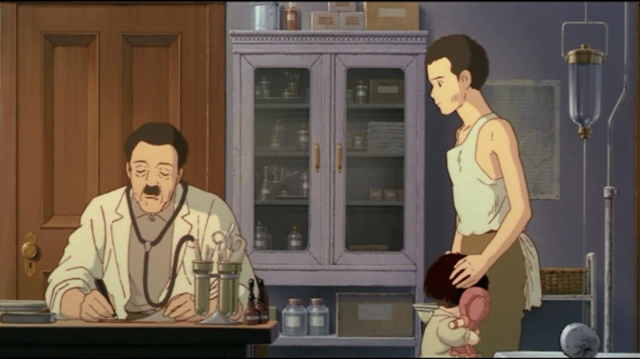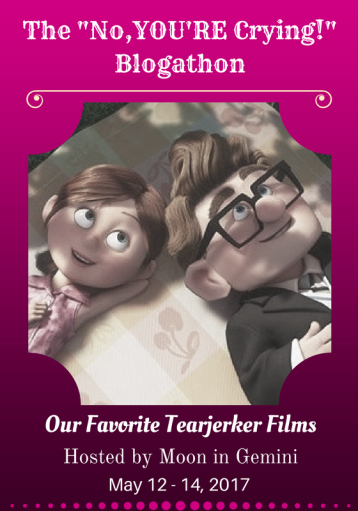
What lingers in the mind is the color. A reddish-pinkish hue, the hue of dying embers. And the glow of the fireflies who rise up with a dreamy slowness like sparks floating upwards. The fireflies die quickly—their lifespan may be a season—and they are easily crushed even by a small child, which is a giant to them. Children, like the fireflies, are also the victims of forces much larger than them—war, hunger, the banality of bureaucracy, the general indifference of the adult world.

In Isao Takahata’s beautifully tragic 1988 film, Grave of the Fireflies, the images and sounds of a cruelly short childhood bring tears to my eyes. The coldness shown by the adults around the two central characters, Seita and his young sister Setsuko, seems to be the most cruel demonstration of a particular Japanese ambivalence toward the value of life, and the meaning of death. These children, who are orphaned by the a firebomb attack during the height of the Second World War, are then forced to fend for themselves in increasingly desperate circumstances. They face the opportunism of relatives who take their few possessions, the unbending will of farmers who will not even sell them food outside of the government rationing, and the brutality of a man who beats Seita when he catches him stealing in order to feed himself and his little sister. A doctor who diagnoses Setsuko with malnutrition offers no help in finding them any cure, when all they need is some food. In the end, Seita receives callous and unfeeling instructions for how to prepare his sister for cremation and burial.

Japanese culture, at least as it can be discerned through its films, has historically has an ambivalent attitude toward the value of individual lives. Ritual suicide, kamikaze fighters, and the persistence of feudal elements in their society all point to a valuing of communal order and duty over any single person’s life. In Grave of the Fireflies, the orphaned children live with their aunt, who is constantly berating Seita for not contributing towards the war effort. The implication is that his life is only of value in terms of its contribution to the greater society. Otherwise he is seen as without value, and to be scorned.
But there is a distinct tension between the society as we see it, and the viewpoint of the filmmakers, who created the film more than 40 years after the events depicted. The film’s sympathies are always with the children. Those characters who uphold the traditional Japanese devotion to duty over compassionate humanity are seen as hypocrites and selfish functionaries. Of all the adults Seita encounters, only a single policeman shows any real compassion, when he releases him, rather than throw him in jail for stealing food. But even his pity does not extend as far as offering real, practical help to the children, and Seita’s shame after this incident is overwhelming.

Roger Ebert, in his “Great Movies” review, felt compelled to make an apologia for the fact that this film happens to be animated. I, too have had the experience of having to convince people to give this film a try, since many people assume that animation is only for children’s films, or that animated films are a lesser genre. Thankfully, this prejudice has never existed in Japan, where films like Grave of the Fireflies have long been appreciated as for their mature and complex artistry, standing alongside the classics of live-action filmmaking. Few films have moved me as much as this story of the cost of war for two young siblings.
The children’s life was brief, but it was dignified and elevated through their fierce love for each other, and the beautiful, sacrificial way in which Seita did everything he could to give his sister joy, despite their suffering. A bathtime game, a tin of sweets, a piggyback ride, or a night filled with the glow of fireflies—all testify to the greatness of human love expressed through small gifts of compassion and sharing. In the reddish glow of the afterlife, the ghosts of the two children are reunited to look back over their sad lives. But the very fact that they are together again, and traveling hand in hand, gives us hope for the idea that love can yet be stronger than the most powerful forms of destruction that human evil can bring to bear.


This post is part of the “No, YOU’RE Crying!” Blogathon, hosted by Moon in Gemini.


Such a beautiful review. You really capture the overall devastation in Japan at the time as well as the struggles and small joys that the brother and sister face. I absolutely love this movie and definitely cried throughout.
LikeLiked by 1 person
Thank you for reading. This is a film that even today with much broader awareness of the Studio Ghibli films, needs more recognition
LikeLiked by 1 person
Truly, only one without a heart could not be moved by this beautiful film.
Thank you for your wonderfully written review, as well as the statement on appreciating the art of animation. I often think of animation as purest form of cinema.
LikeLiked by 1 person
Thanks for reading. I think one of the advantages of this film being animated, is that since it centers on child protagonists, there is not the tricky limitation of the quality of child acting being able to carry the weight of this story. Though cinema history features some incredible child performances, it is also littered with many subpar ones. And even the good ones have a tendency to draw attention to the quality of the performance, rather than the story itself, while animation provides a layer of abstraction to that presentation. The visual part of the acting is done by very considered process of the animator, rather than the real-time choices of a child.
LikeLike
Thanks for reviewing this film. I would have never considered it, and that would have been a shame, considering how profoundly moving it appears to be.
I also agree with your comments (above) re: child acting. I can see why animation would be an advantage when telling this story.
LikeLiked by 1 person
Thank you for reading. Ebert considered other reasons why animation was the ideal form for this story (though it was apparently remade in live action, I think for Japanese TV).
“This film proves, if it needs proving, that animation produces emotional effects not by reproducing reality, but by heightening and simplifying it, so that many of the sequences are about ideas, not experiences.”
LikeLiked by 1 person
Oh yes – brilliant point about heightening and simplifying reality. That probably wouldn’t have occurred to me.
I mean it: I am so glad I read your review before watching this.
LikeLiked by 1 person
Well, that was Ebert—he was known for such brilliance. 😉
LikeLiked by 1 person
As I was saying to two other people who reviewed Japanese films for this blogathon, I haven’t seen that many, but now I want to. Especially this one! I LOVE animated films that break out of the children’s movie category and this sounds superb.
Thank you so much for contributing to the blogathon!
LikeLiked by 1 person
Yeah, I do love Japanese cinema. If you haven’t seen any of Miyazaki’s films, they are all worth seeing. Thanks again for hosting the blogathon!
LikeLiked by 1 person